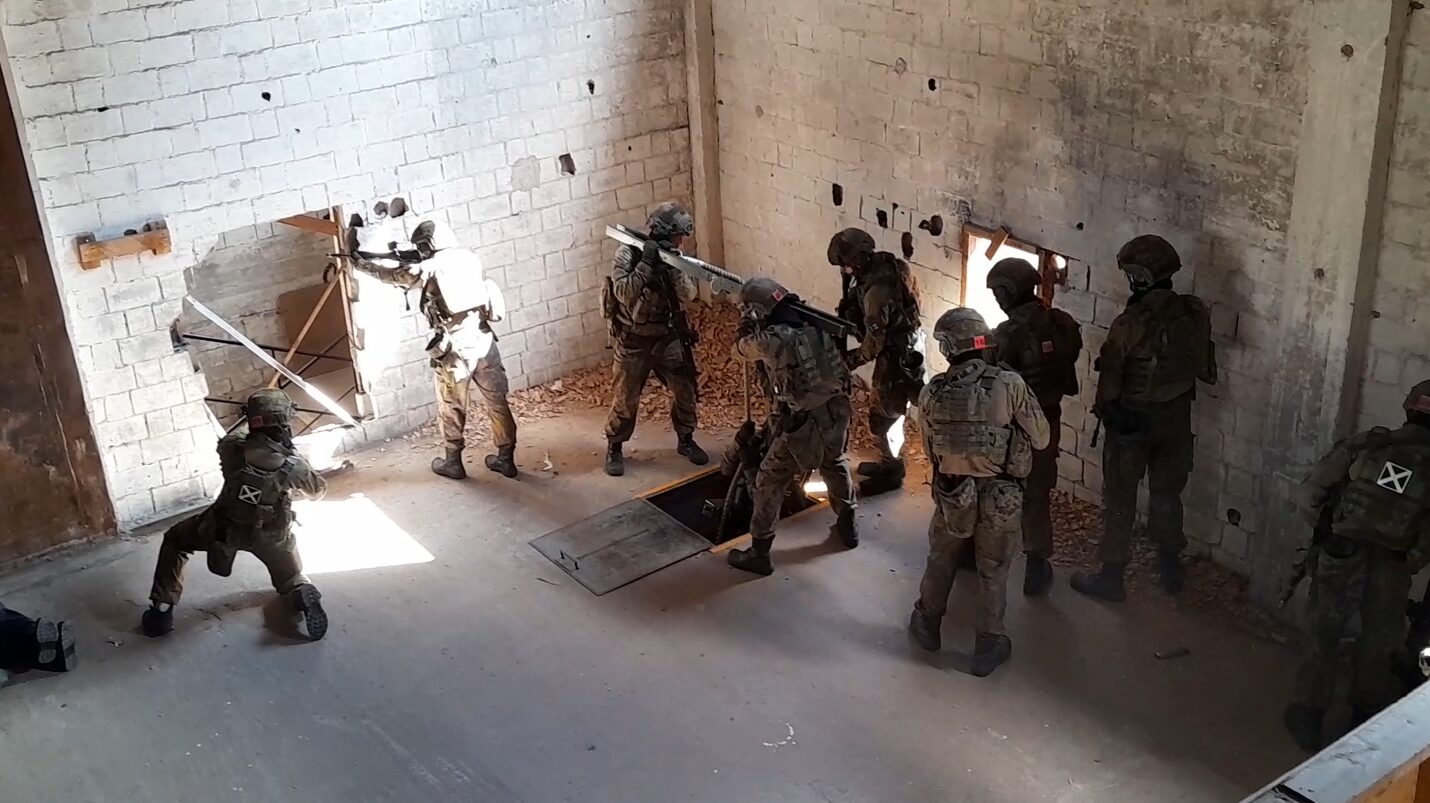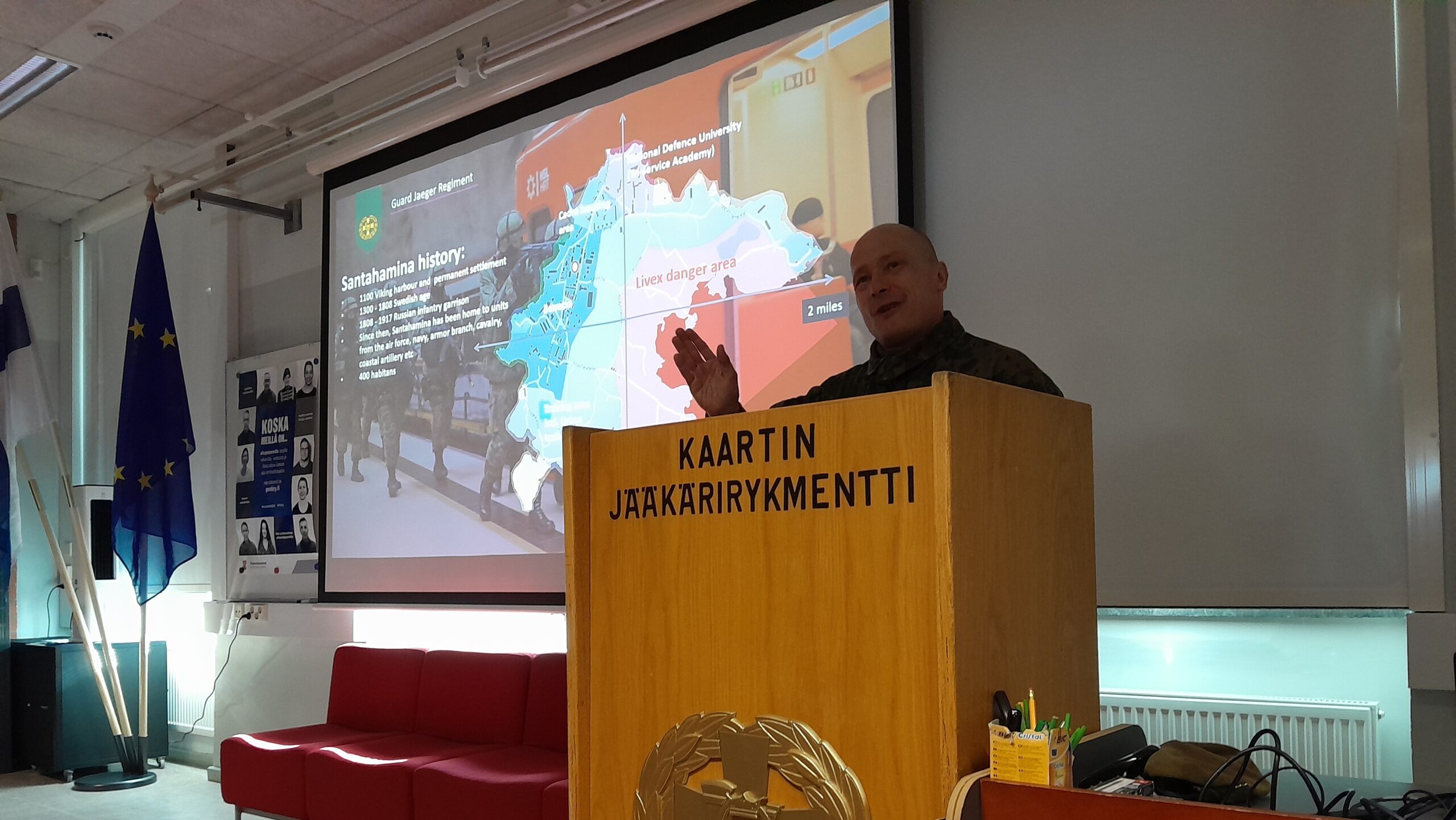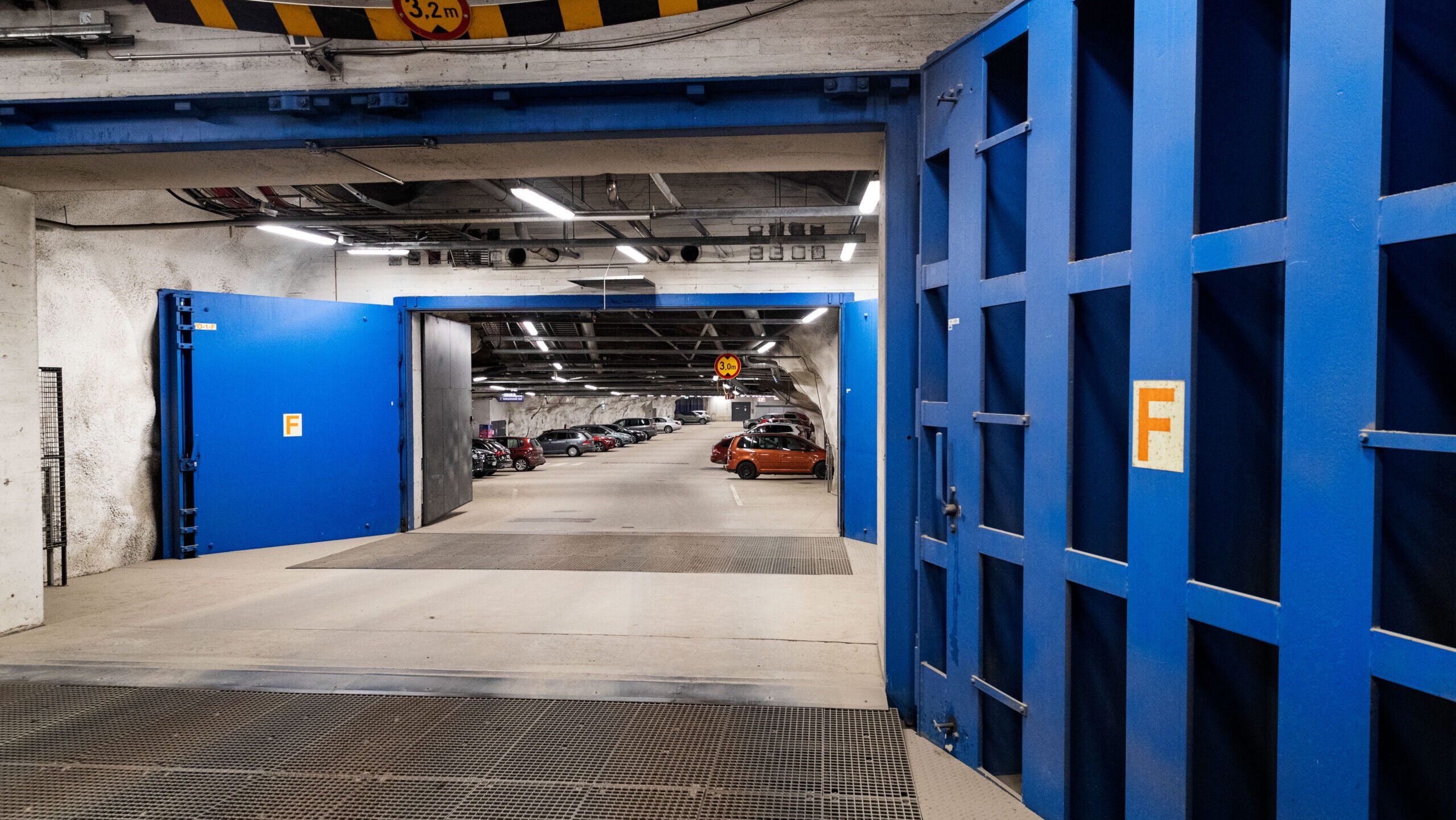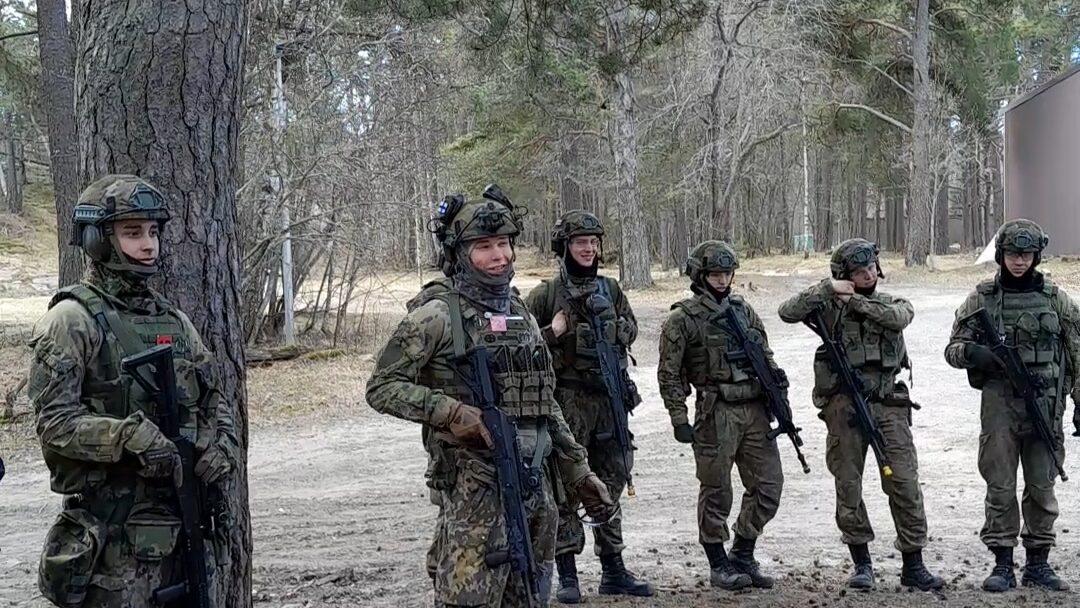Finnish troops training under the Guard Jaeger Regiment conduct a building-clearing exercise. (Lee Ferran / Breaking Defense)
SANTAHAMINA, Finland — A light metallic rattle comes from one end of the warehouse, a grenade bouncing on the concrete floor after it was tossed inside through an open doorway. There’s a loud bang, and then camouflaged troops pour into the first room, rifles up and at the ready, one after the other.
An enemy combatant is immediately taken into custody as the soldiers peel off to do different jobs. The warehouse is divided into several rooms, with one long hallway running down its whole length in the middle. A machine gunner takes a prone position at the beginning of the hallway, providing cover and trading occasional, deafening fire with the armed opposition who pop in and out of view at the far end of the corridor.
Meanwhile, squads of riflemen clear the rooms along both sides of the hallway in a laborious, deliberate process, as they creep towards the gunmen at the back of the warehouse. Eventually, they converge on the final, larger room at the end of the hallway. By now multiple gunmen have been neutralized, but the soldiers are cautious.
RELATED: Finnish defense chief: Finland is dedicated to NATO’s Northern, Baltic needs
A grenade is rolled into this room as well, but it doesn’t explode. They soldiers file in anyway, discovering all their enemies are already down, but also finding a large hole in the far wall and another in the ground. A pair of soldiers take up guard positions at the hole in the wall, while others call back to their comrades at the warehouse entryway. Seconds later, two soldiers run in, carrying a metal bar across their shoulders from the middle of which hangs a thick rope. The two take positions on either side of the hole, drop the rope in, and then, one by one, others grab the rope and slide down into the hole and out of view, pursuing their quarry underground.
“Alright, the exercise is ending,” says a voice from above, belonging to Col. Matti Honko, who has been watching the performance from wooden walkways that also run the length of the warehouse and provide an overhead view of his troops’ movement.

Finnish conscripts rappel into a hole during a shoot-house exercise on May 7, 2024. (Lee Ferran / Breaking Defense)
Honko is the head of Finland’s Guard Jaeger Regiment, which is charged with training soldiers here on a military base in Santahamina, Finland, just a few miles outside downtown Helsinki, focusing on urban combat in service of a mission that has never seemed more relevant: the defense of the capital from an invading force.
Honko appears mostly satisfied with the non-live-fire exercise. It took about six minutes to clear the building, which Honko tells Breaking Defense was “a little slow.” Addressing the grenade that failed to explode, he notes dryly, “It helps if you pull the pin.”
The relative sluggishness and mistakes may be forgiven, as the troops are not hardened special operations forces but conscripts just four months into training. The young troops, speaking afterwards to an audience from the Kaplan Public Service Foundation, are shy but content, acknowledging areas in which they can improve.
Does it feel odd to prepare to defend a city in which many of them were born and raised? No, they answer, it’s just the way it is.
That attitude of casual stoicism is pervasive among both the young soldiers and senior military and political officials with whom KPSF spoke during a trip here in early May. (Breaking Defense accepted accommodation from KPSF in Finland and Estonia.)
Finland has been prepared to defend its homeland with a whole-of-society approach for decades — or centuries, depending how one counts. And while Russia’s full-scale invasion of Ukraine in February 2022 may have galvanized the public to push Helsinki to join NATO, Honko said the Finnish military’s real wake-up call came nearly a decade earlier when Russia took over Crimea.

Finland’s Col. Matti Honko briefs a group from the Kaplan Public Service Foundation about the Finnish military on May 7, 2024. (Lee Ferran / Breaking Defense)
Russia’s stealthy invasion there, he said, showed that the old manuals were “all obsolete,” that Finland had been preparing for a more formal war than the one they may have to fight. (On its website, the Finnish Army says the “capabilities” of the Guard Jaeger Regiment can be employed in “hybrid” situations.)
Honko and other Finnish officials said that while NATO membership in April changed the Finnish military’s thinking “overnight,” much of the nation’s self-defense plans remain as they were before — based on an attitude baked into the national character.
“[O]ur history has been to a large extent about survival and living not in the shadow but under the breath of the giant in the East,” Mikael Antell, deputy director general of the Finnish Foreign Ministry’s political department, told the KPSF group in a separate discussion in Helsinki. “And I think [anyone] you ask on the street can somehow feel this breath. But having said that, [it] has never meant that Finns have been afraid of Russians — quite the opposite…
“Here I would put it more with the words ‘We have never been afraid, but constantly concerned.’ And that makes a difference,” he said. “Because we have always been concerned, we’ve always been prepared.”
That preparation comes in the form of universal male conscription, augmented by volunteer female fighters, which Honko said not only provides a massive reserve force at the ready but also encourages national “cohesion” since every family has a similar experience and has made similar sacrifices, no matter their station in society. (He said the debate about extending conscription to women reemerges from time to time, but for his part, he said the army currently doesn’t have the infrastructure to absorb twice as many conscripts, which would mean adjusting to “selective” conscription that he fears would erode that national cohesion.)
More broadly, Finnish defense policy chief Janne Kuusela said the entire country has the ability to enter what he called “war mode.” Helsinki is littered with underground bunkers, preparations have been made to have food and fuel in store for months, should it come to it, and Antell said the “elite from the business administration, politics, culture sector, etc.” regularly train with the military to know how to best leverage their capabilities in the event of a conflict.

A parking area during a media tour in the Merihaka underground civil defense shelter in Helsinki, Finland, on Monday, April 25, 2022. (Roni Rekomaa/Bloomberg via Getty Images
Antell said Finland’s membership with NATO, with its Article 5 mutual defense clause, has increased deterrence for Russia, but he and others don’t take the security umbrella for granted.
“What I think I dare to say, and proudly so, is that we don’t enter NATO expecting that NATO will do everything for us, but the opposite,” he said. “We are quite proud to be a net contributor of security. And the fact that the attitude and approach is still that we continue to be able to defend the whole country.”
Whether Russian President Vladimir Putin would risk a war with NATO by moving on a member nation remains to be seen — opinions vary wildly, generally based on proximity of the speaker to the Russian border. But should it come in Finland, Ukraine’s experience would dictate that Helsinki would be among the first, key targets. And that’s where the soldiers trained at Santahamina would come in, joining the ranks of virtually every military-aged male in the country.
In the minutes after the shoot-house exercise, one trainer walks down a wooden ramp from the warehouse out into the wooded area around the base, while his soldiers gather a few yards away, smiling and chatting quietly with each other. Under the sun, the Russian threat may have seemed very far away, but it’s forever in the back of mind.
The exercise went “pretty well,” the instructor told Breaking Defense. “A few tweaks and it can be better.”

Finnish conscript troops discuss a building-clearing exercise after an early May 2024 demonstration. (Lee Ferran / Breaking Defense)
















.jpg?itok=F2C4uk0x)




Discussion about this post